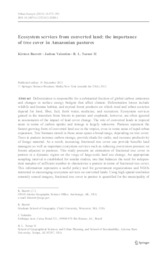Ecosystem services from converted land: the importance of tree cover in Amazonian pastures.
Ecosystem services from converted land: the importance of tree cover in Amazonian pastures.
Author(s): BARRETT, K.; VALENTIM, J. F.; TURNER II, B. L.
Summary: Deforestation is responsible for a substantial fraction of global carbon emissions and changes in surface energy budgets that affect climate. Deforestation losses include wildlife and human habitat, and myriad forest products on which rural and urban societies depend for food, fiber, fuel, fresh water, medicine, and recreation. Ecosystem services gained in the transition from forests to pasture and croplands, however, are often ignored in assessments of the impact of land cover change. The role of converted lands in tropical areas in terms of carbon uptake and storage is largely unknown. Pastures represent the fastest-growing form of converted land use in the tropics, even in some areas of rapid urban expansion. Tree biomass stored in these areas spans a broad range, depending on tree cover. Trees in pasture increase carbon storage, provide shade for cattle, and increase productivity of forage material. As a result, increasing fractional tree cover can provide benefits land managers as well as important ecosystem services such as reducing conversion pressure on forests adjacent to pastures. This study presents an estimation of fractional tree cover in pasture in a dynamic region on the verge of large-scale land use change. An appropriate sampling interval is established for similar studies, one that balances the need for independent samples of sufficient number to characterize a pasture in terms of fractional tree cover. This information represents a useful policy tool for government organizations and NGOs interested in encouraging ecosystem services on converted lands. Using high spatial resolution Rio Branco, Brazil. A semivariogram and devolving spatial resolution are employed to determine the coarsest sampling interval that may be used, minimizing effects of spatial autocorrelation. The coarsest sampling interval that minimizes spatial dependence was about 22 m. The area-weighted fractional tree cover for the study area was 1.85 %, corrected for a slight bias associated with the coarser sampling resolution. The pastures sampled for fractional tree cover were divided between ?high? and ?low? tree cover, which may be the result of intentional incorporation of arboreal species in pasture. Further research involving those ranchers that have a higher fractional tree cover may indicate ways to promote the practice on a broader scale in the region.
Publication year: 2013
Types of publication: Journal article
Unit: Embrapa Acre
Keywords: Amazonia, Cambio climático, Canopy, Climate change, Cubierta (plantas), Deforestación, Deforestation, Desmatamento, Ecosystem services, Environmental impact, Impacto Ambiental, Mudança Climática, Pastagem, Pastizales, Pastures, Planta de Cobertura, Servicios ecosistémicos, Serviços ecossistêmicos
Observation
Some of Embrapa's publications are published as ePub files. To read them, use or download one of the following free software options to your computer or mobile device. Android: Google Play Books; IOS: iBooks; Windows and Linux: Calibre.
Access other publications
Access the Agricultural Research Database (BDPA) to consult Embrapa's full library collection and records.
Visit Embrapa Bookstore to purchase books and other publications sold by Embrapa.

